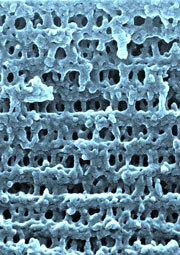| 삼투압 원리를 이용한 나노구멍체(Nanopores) 제조 | ||||||
| KISTI 미리안『글로벌동향브리핑』 2011-12-02 | ||||||
새로운 여러 영역에서 나노구멍 재료들이 많이 응용되면서 중요해지고 있다. 높은 표면적은 촉매로 사용하기에 이상적이며, 모공의 촘촘한 구조는 포토닉스(photonics)와 여과 장치에 사용하기에 훌륭하다. 그러나, 나노구멍체를 만드는 과정은 항상 간단한 것만은 아니다. 재료의 한 구성 요소(모공이 됨)는 제거될 필요가 있고, 구멍은 구조를 통해 연결되어야 하며 바깥과도 또한 연결되어야 한다. 영국 캠브리지 대학교의 Easan Sivaniah 박사팀은 재료의 작은 구성 요소는 연결되어 있지 않으면서, 내부 또는 외부는 제거하는 방법을 고안했다. 연구팀이 개발한 방법을 보여주기 위해, 연구팀은 PMMA(polymethyl methacrylate)의 작은 구로 채워진 폴리스티렌(polystyrene)을 사용했다. 다음으로, 연구팀은 작은 도메인을 형성하도록 PMMA를 연속적인 올리고머 안으로 부서뜨리기 위해 복합재료에 적외선을 조사했다. 다음은, 중요한 단계에로, 연구팀은 초산으로 재료를 젖게 해서 PMMA가 녹게 했다. 비록 초산이 PMMA 올리고머에 직접 도달하지는 못하지만, 삼투압을 통해 폴리스틸렌이 확산될 수 있으며, 점진적으로 PMMA 도메인을 채웠다. 결과적으로, 도메인은 흡수한 산으로 점점 크게 자라면서, 벽을 부수는데, 이 과정은 집단 삼투압 충격(collective osmotic shock)이라고 알려져 있으며, 폴리스티렌에 많은 나노구멍체를 남긴다. Sivaniah 박사는 “최적화로, 이번에 개발한 방법은 지속적으로 기업 공정에 이용될 수 있으며, 기술의 응용성을 향상시킬 수 있다”라고 말했다. [그림] 초산과 PMMA의 혼합물의 팽창은 나노구멍체 내의 폴리스틸렌 구조를 풍부하게 한다. 이미 연구팀은, 나노구멍체 폴리스틸렌이 염료를 제거할 수 있는 물 필터와 일차원 포토닉스 결정으로서 역할을 할 수 있음을 보였다. Sivaniah 박사는 다른 나노구멍체 재료는 폴리스틸렌 나노구멍체와 다른 물질을 채운 다음, 폴리스틸렌을 녹임으로 ‘석고 주조’방식으로 만들었다고 말했다. 영국 맨체스터 대학에서 재료 분야 전문가인 Martin Attfield 박사는 이번 연구는 삼투압 원리를 이용한 우아하고 새로운 방법이라고 평가했다. 보고된 재료는 상대적으로 비싸지 않은 시약과 다양한 곳에 응용되고 있으며, 다른 원소로부터 만들어진 다른 재료의 호스트를 형성하는 템플릿으로 만들어진 것이라고 박사는 덧붙였다. “모든 측면에서 이번에 개발된 방법론은 기존 시스템의 성능을 향상시키거나 교체할 수 있는 잠재력을 가지고 있음을 보여주고 있다”고 말했다.
|
Shocking osmotic route to nanopores
28 November 2011
Scientists in the UK have come up with a new method to create nanoporous materials. The method, which uses osmosis to drive a minor component from a material, should make nanoporous materials easier to manufacture for applications such as filtration.

The expansion of a mix of acetic acid and PMMA created a polystyrene structure rich in nanopores © Nat. Mater. |
Now, Easan Sivaniah from the University of Cambridge and colleagues have devised a method where the minor component of a material does not have to be linked up, inside or outside, to be removed. To demonstrate their method, the researchers used polystyrene filled with tiny spheres of polymethyl methacrylate (PMMA). They then exposed the composite material to ultraviolet light, which broke the PMMA down into its constituent oligomers, forming small domains.
In the next, crucial, step, the researchers wetted the material with acetic acid, which dissolves PMMA. Although the acetic acid couldn't reach the PMMA oligomers directly, it could diffuse through the polystyrene via osmosis, gradually filling up the PMMA domains. Eventually, the domains grew so big from the absorbed acid that they broke through the walls - a process known as collective osmotic shock - leaving the polystyrene full of nanopores. 'With optimisation this could be applied to continuous industrial processes, enhancing the applicability of the technique,' says Sivaniah.
The researchers have already demonstrated that the nanoporous polystyrene can function as both a water filter that can remove dye, and a one-dimensional photonic crystal. Sivaniah says that different nanoporous materials could even be made using a 'plaster cast' approach, by filling the polystyrene nanopores with another substance, and then dissolving away the polystyrene.
Martin Attfield, an expert in nanoporous materials at the University of Manchester, UK, says the work is an 'elegant and novel' way of using osmotic shock. 'The reported materials are formed from relatively inexpensive reagents, and are highly applicable for a diverse array of applications and as templates to form a host of other materials made from other elements,' he adds. 'All these aspects indicate the great potential for this methodology to provide new materials that may enhance the performance of, or replace, existing systems.'
Jon Cartwright

댓글 없음:
댓글 쓰기